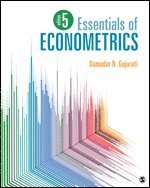
- Format
- Häftad (Paperback)
- Språk
- Engelska
- Antal sidor
- 632
- Utgivningsdatum
- 2023-03-30
- Upplaga
- 1
- Förlag
- SAGE Publications, Inc
- Illustrationer
- Illustrations, unspecified
- Dimensioner
- 252 x 202 x 24 mm
- Vikt
- Antal komponenter
- 1
- ISBN
- 9781071850398
- 1158 g
Essentials of Econometrics
- Skickas från oss inom 5-8 vardagar.
- Fri frakt över 249 kr för privatkunder i Sverige.
Passar bra ihop
De som köpt den här boken har ofta också köpt Knife av Salman Rushdie (inbunden).
Köp båda 2 för 2161 krKundrecensioner
Fler böcker av Damodar N Gujarati
-
Linear Regression
Damodar N Gujarati
Damodar N. Gujarati’s Linear Regression: A Mathematical Introduction presents linear regression theory in a rigorous, but approachable manner that is accessible to students in all social sciences. This concise title goes step-by-step through...
Övrig information
Damodar Gujarati (M.B.A. and Ph.D., both from University of Chicago) is Professor Emeritus of economics at the United States Military Academy at West Point. Prior to that, he taught for 25 years at the Baruch College of the City University of New York (CUNY) and at the Graduate Center of CUNY. He is the author of Government and Business, (McGraw Hill, 1984), the bestselling textbook Basic Econometrics (5th edition, 2009, with co-author Dawn Porter), as well as Essentials of Econometrics (4th edition, 2009, also with co-author Dawn Porter), both published by McGraw-Hill, and also Econometrics by Example (2nd edition, 2014, Palgrave-Macmillan). His experience spans business, consulting, and academia.
Innehållsförteckning
Acknowledgments Preface About the Author Chapter 1. The Nature and Scope of Econometrics 1.1 What Is Econometrics? 1.2 Why Study Econometrics? 1.3 The Methodology Of Econometrics 1.4 The Road Ahead Key Terms and Concepts Questions Problems Appendix 1A: Economic Data on the World Wide Web PART I. THE LINEAR REGRESSION MODEL Chapter 2. Basic Ideas of Linear Regression: The Two-Variable Model 2.1 The Meaning of Regression 2.2 The Population Regression Function (PRF): A Hypothetical Example 2.3 Statistical or Stochastic Specification of The Population Regression Function 2.4 The Nature of the Stochastic Error Term 2.5 The Sample Regression Function (SRF) 2.6 The Special Meaning of the Term Linear Regression 2.7 Two-Variable Versus Multiple Linear Regression 2.8 Estimation of Parameters: The Method of Ordinary Least Squares 2.9 Putting It All Together 2.10 Some Illustrative Examples 2.11 Summary Key Terms and Concepts Questions Problems Optional Questions Appendix 2A: Derivation of Least Squares Estimators Chapter 3. The Two-Variable Model: Hypothesis Testing 3.1 The Classical Linear Regression Model 3.2 Variances and Standard Errors of Ordinary Least Squares Estimators 3.3 Why OLS? Properties of OLS Estimators 3.4 The Sampling, or Probability, Distributions of OLS Estimators 3.5 Hypothesis Testing 3.6 Hypothesis Testing: Some Practical Aspects 3.7 How Good Is The Fitted Regression Line: The Coefficient of Determination, r2 3.8 Reporting the Results of Regression Analysis 3.9 Illustrative Examples 3.10 Comments on the Illustrative Examples 3.11 Forecasting 3.12 Normality Tests 3.13 Summary Key Terms and Concepts Questions Problems Chapter 4. Multiple Regression: Estimation and Hypothesis Testing 4.1 The Three-Variable Linear Regression Model 4.2 Assumptions of the Multiple Linear Regression Model 4.3 Estimation of the Parameters of Multiple Regression 4.4 Goodness of Fit of Estimated Multiple Regression: Multiple Coefficient of Determination, R2 4.5 Antique Clock Auction Prices Revisited 4.6 Hypothesis Testing In A Multiple Regression: General Comments 4.7 Testing Hypotheses About Individual Partial Regression Coefficients 4.8 Testing the Joint Hypothesis That B2 = B3 = 0 Or R2 = 0 4.9 Two-Variable Regression In the Context of Multiple Regression: Introduction to Specification Bias 4.10 Comparing Two R2 Values: The Adjusted R2 4.11 When to Add an Additional Explanatory Variable to a Model 4.12 Restricted Least Squares 4.13 Illustrative Examples 4.14 Summary Key Terms and Concepts Questions Problems Appendix 4A.1: Derivations of OLS Estimators Appendix 4A.2: Derivation of Equation (4.31) Appendix 4A.3: Derivation of Equation (4.49) Chapter 5. Functional Forms of Regression Models 5.1 How to Measure Elasticity: The Log-Linear Model 5.2 Multiple Log-Linear Regression Models 5.3 How to Measure the Growth Rate: The Semilog Model 5.4 The Lin-Log Model: When the Explanatory Variable Is Logarithmic 5.5 Reciprocal Models 5.6 Polynomial Regression Models 5.7 Regression Through the Origin: The Zero Intercept Model 5.8 A Note on Scaling and Units of Measurement 5.9 Regression on Standardized Variables 5.10 Summary of Functional Forms 5.11 SUMMARY Key Terms and Concepts Questions Problems Appendix 5A: Logarithms Chapter 6. Qualitative or Dummy Variable Regression Models 6.1 The Nature of Dummy Variables 6.2 ANCOVA Models: Regression on One Quantitative Variable and One Qualitative Variable With Two Categories 6.3 Regression on One Quantitative Variable and One Qualitative Variable With More Than Two Classes or Categories 6.4 Regression on One Quantiative Explanatory Variable and More Than One Qualitative Variable 6.5 Comparing Two Regessions 6.6 The Use of Dummy Variables In Seasonal Analysis 6.7 What H
Du kanske gillar
-
Frågor & svar
Transformed
Marty Cagan
Inbunden


